Victorian Gothic has supplied rich material for the cinema, with many film-makers offering imaginative versions of the best known texts. Bram Stoker’s Dracula (1897) has been the most popular choice, establishing a tradition that includes F. W. Murnau’s Nosferatu (1922), Tod Browing’s treatment (1931), Terence Fisher’s Hammer version (1958) and Francis Ford Coppola’s lurid interpretation of 1992. Each of these has been the subject of extended scrutiny.
The same is true of Jack Clayton’s The Innocents (1961), an adaptation of Henry James’s celebrated novella, The Turn of the Screw (1898). Presented strictly as a ghost rather than a horror story, The Innocents is widely regarded as one of the most subtle and thought-provoking films of its type, intermingling the supernatural and the psychological in a complicated blend. Highly sophisticated, it has always attracted high praise: François Truffaut described it as the one of the finest creations of British cinema, among the best since Hitchcock left for America (Sinyard 81); Pauline Kael called it the ‘best ghost story I’ve ever seen’ (Frayling 6); and for Christopher Frayling it is no less than the ‘finest ghost movie based on the finest ghost story’ (11). In a genre dominated by routine ‘B’ films, Clayton’s work is a powerful auteur piece, expensively made and designed for an adult audience.
Criticism has focused on the director’s deployment of cinematic techniques to suggest the novella’s possibilities while maintaining James’s ambivalence: is the Governess really seeing apparitions of the lovers Quint and Jessel, or are they projections of her own suppressed sexuality? That uncertainty informs every aspect of the film. For some critics ambiguity itself is the film’s theme, a process of obfuscation traced in detail by James Palmer (1977) and Edward Recchia (1987). Clearly, The Innocents tries to recreate the uncertainties which constitute the main interest in The Turn of the Screw, and the manner of its adaptation is necessarily complicated and demanding, especially given the linguistic richness of James’s text. In the words of Anthony Mazzella:
Any filmmaker attempting a film adaption [of James’s novella] is challenged with finding a visual way of rendering such apparently infinite intricacies of prose. How do you use visual images and sound constructions to accomplish in film what James did in words? [Henry James Goes to the Movies]
Mazzella suggests that the next stage in his argument will be a comparison of the verbal and filmic texts in order to establish how Clayton, working with a script by Truman Capote, facilitated this process of transmutation. What is surprising, however, is the fact that neither Mazzella nor any of the commentators writing on The Innocents have adopted this critical strategy, preferring in each case to explore the film’s complexities without linking them in detail, or even linking them at all, to James’s original effects. Nevertheless, Clayton’s work can only be understood as an adaptation by engaging in a close reading of the relationship between James’s ambiguities and the director’s. This approach enables us to answer another question: how effective is The Innocents as a version of The Turn of the Screw? Of key importance are three areas of comparison: the ghosts as real phenomena; the ghosts as hallucinations; and the explanations that might be advanced for their appearance.
The Ghosts are Real
Truman Capote’s reading of The Turn of the Screw was based on William Archibald’s stage version of 1950, with additional material by John Mortimer. Clayton had originally commissioned Archibald to do the screenplay, but was dissatisfied with the work and passed it to Capote, who produced the final script. Though he cuts, rearranges and adds material, Capote preserves the idea that the ghosts could be real or unreal in equal measure and Clayton, likewise, preserves what Recchia describes as ‘a delicate balance’ (32) between the two. Tellingly, Clayton would not direct his cast to one interpretation or the other and refused to inform his lead, Deborah Kerr, who plays the Governess – unnamed in James’s text, but called Miss Giddens in the film – how she should act the part other than always remembering to be ambiguous (Sinyard 88).
This directorial focus reflects how carefully Clayton wanted to recreate a filmic version of James’s oscillation between the telling of a ghost story and the telling of a psychological drama. Indeed, Clayton was generally concerned with the interplay of realism and the workings of the mind, embodying both strands in his small catalogue of work. The Room at Top (1957) and The Pumpkin Eater (1964) are realist, ‘kitchen sink’ dramas in the manner of the British New Wave, but Something Wicked This Way Comes (1983), a version of a short story by Ray Bradbury, is dream-like and fantastical. In The Innocents he manages to combine both elements.
The film can be read purely as a ghost story which responds to elements in James’s story that suggest the reality of Giddens’s apparitions. These are focused on the key encounters and provide cinematic equivalents to the scenes in The Turn of the Screw where Quint and Jessel are plausibly reported. The first and most convincing of these is the moment when the Governess sees Quint looking in through the window. James’s narrator describes this sighting, her second, in terms which insist on its materiality:
One step into the room had sufficed; my vision was instantaneous; it was all there. The person looking straight in was the person who had already appeared to me. He appeared thus again with I won’t say greater distinctness, of that what impossible …it was as if I had been looking at him for years and had known him always. [The Turn of the Screw, 35–36]
The Governess’s certainty is conveyed in simple but direct language: ‘it was all there’, and impossible to see with ‘greater distinctness’. She later reports her vision with journalistic intensity, telling Mrs Grose that:
He has red hair, very red, close-curling and a pale face, rather long in shape, with straight, good features and a little, rather queer whiskers that are a red as his hair. His eyebrows are, somehow, darker … His eyes are sharp, strange – awfully … they’re rather small and very fixed. His mouth’s wide, and his lips are thin, and except for his little whiskers he’s quite clean–shaven. [40–41]
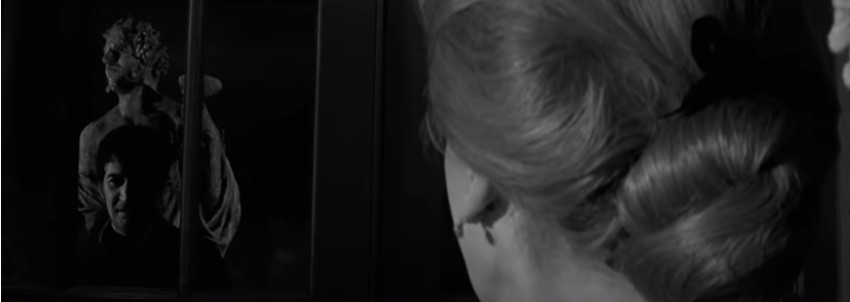
The moment in The Innocents when Giddens encounters Quint looking in through the window. Freddie Francis’s black and white cinematography combines width of composition with depth of field
The specificity of the Governess’s portrait of Quint suggests the veracity of the encounter, and Clayton provides an exact parallel. Though Quint’s red hair cannot be reproduced by Freddie Francis’s cinematography – the film is in black and white – the character does have dark eyebrows, a long face and thin lips with ‘little whiskers’; though not exactly clean-shaven, he does peer into room, recreating the ‘sharp, strange’ eyes. Played by Peter Wingarde with great intensity, Quint is shown approaching and then in close-up, pressed to the glass: the effect is visceral, and as in the text the materiality of the image suggests that the vision is plausibly ‘there’.
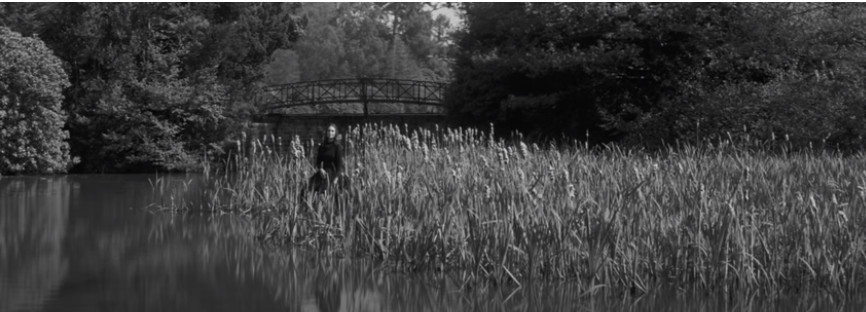
Giddens’s first encounter with Jessel at the lake. The image is a complex piece of uncanniness, with the ghost appearing both mannequin-like and realistic, occupying a real space but standing where it is impossible to stand; the figure’s silence and immobility adds to the sense of menace and disorientation.
Clayton also follows James in his specification of the second ghost, Ms. Jessel; in the written text she is described as being costumed in her mourning dress, with a pale complexion, and in the film (as played by Clytie Jessop) she is presented in a parallel way, wearing black and with a broad face, the whiteness of which is accentuated in contrast to the darkness of her costume. These details again emphasise the notion of materiality, and Clayton stresses her physical presence not only by placing her on the ‘other side’ of the lake (49) as she appears in the novella, but by positioning her among the rushes as an accentuated dark vertical. Francis’s photography in stark monochrome once again suggests veracity and here, as in the representation of Quint, and in the appearance of Jessel when she turns up in the classroom, it is difficult to dismiss the figures as not having an objective reality. In these sequences at least, the filmmaker reproduces the Governess’s invocation of ‘the truth’ (44) and ‘Facts’ (49), with ‘no ambiguity in anything’, ‘conviction’ and ‘certitude’ (50). Viewed in these terms, it is more than possible to interpret The Innocents as a conventional supernatural thriller which recreates the workings of an equally traditional text; as James Palmer remarks of the film and its literary source, ‘we must grant a reality to the ghosts’ (214), and at least consider the idea that Ms Giddens is a woman of integrity struggling with the manifestations of an evil haunting.
The Ghosts Aren’t Real
The physicality of film, as a medium based on photography, privileges its capacity to represent the tangible. This is a situation that makes Clayton’s piece into a thoroughly troubling invocation of the supernatural in which the phantoms seem to be corporeal invaders from a spiritual domain. Such imposing ghosts would frighten any observer, as they do Ms Giddens. Kerr’s performance is a powerful representation of this fear, especially in her varying facial expressions as she progresses from puzzlement to paralysed terror.
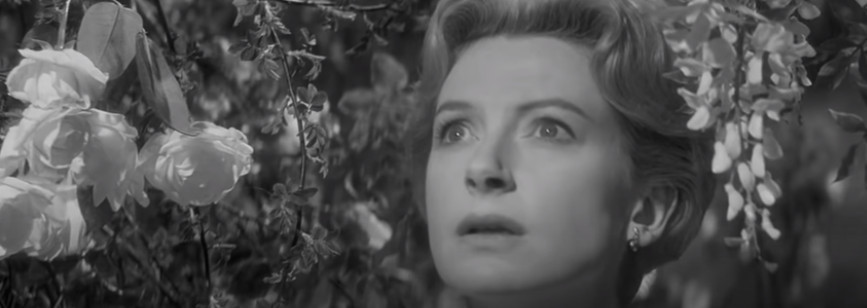
Kerr’s facial expressions add much to the representation of what may be a descent into madness. The scene here is the moment when she sees Quint on top of the tower.
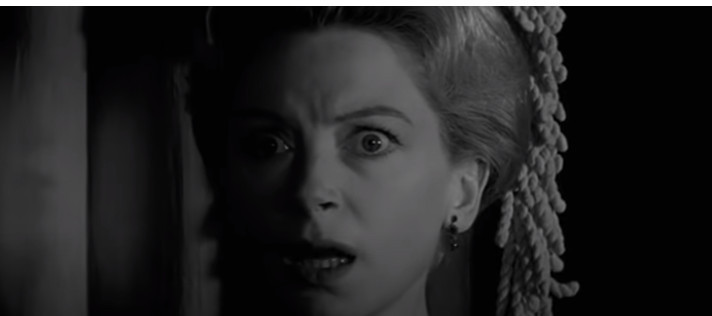
Sheer terror: Kerr’s wide-eyed fear as she confronts Quint. The film’s extreme close-ups were achieved by positioning the camera within inches of her face, creating a detailed and claustrophobic effect.
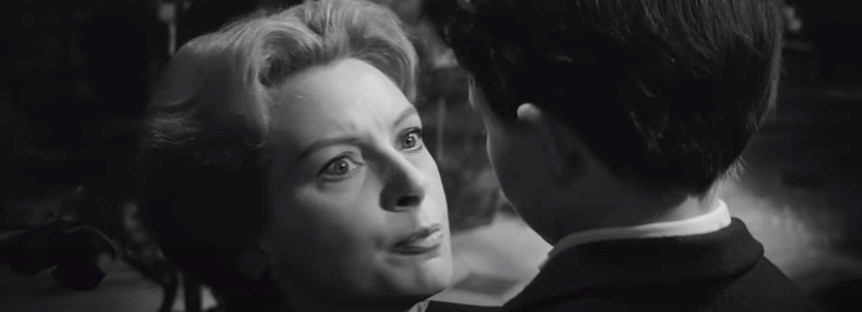
Another facial expression as Giddens/Kerr tries to winkle Miles’s secret out of him.
These disconcerting emotions are not in doubt. But are the ghosts objectively real? That question is posed because they ae viewed entirely from the Governess’s point of view; James’s account is related in the first person, and Clayton, offering a filmic equivalent, suggests that all we are seeing is through the eyes of someone who may be an unreliable narrator. Using the subjective camera and subjective sound, the director follows the author in making ‘consciousness as integral working part’ of his narrative (Reccio 28), and it is quite possible that we are not seeing is not reality but ‘a woman’s fantasies’ (32).
James suggests this situation by manipulating his text and Clayton, once again, is closely observant of the author’s imagery and ambivalent lexicon, converting the author’s words into filmic language. This process is exemplified by comparing the treatments of the unnerving moment when Giddens first sees Quint, apparently at the top of the tower.
James constructs the scene as a rapid transition from peaceful contentment to alarm. In the first instance she is seen absorbed in peaceful reflection; the atmosphere is the ‘plump’ warmth of a ‘long June day’ (Turn of Screw, 26–27) and the garden, where she walks, a calming domain of plenty. James does not specify the flora apart from the plantations (27), but Clayton emphasises the notion of the grounds as paradise, showing Giddens surrounded by lush vegetation, white roses (a recurrent emblem), and framed by the intense sound of birdsong. The director in this sense amplifies the character’s reflection on her ‘charming’ experience (26)
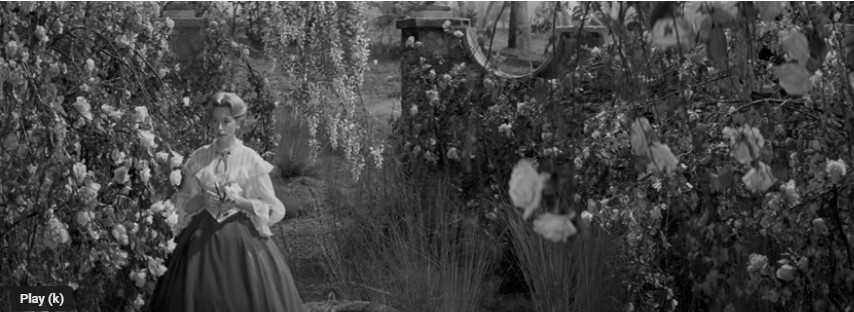
Bly as paradise, with super-charged floral imagery that suggests both innocence and the sexuality of the natural world as Giddens is surrounded by blooming flowers.
Working with his cinematographer, he also matches James’s description of her ‘bewilderment of vision’ (27) as she thinks she sees the figure of Quint with ‘sharpness’ (29) but concedes that the ‘vision’ (27) is occluded by the ‘twilight’ (27). Indeed, Francis’s photography is deeply ambivalent: first of all, the tower-top presence is clearly registered, but this situation is almost immediately dissolved into defocused and dazzling light, an effect intensified by the blurred forms of pigeons which fly in slow motion in front of what is supposed to be ‘an unknown man’ (29). The narrator in James’s text claims that she has seen a well-defined face, as if it ‘were a picture in a frame’ (29), but the film version accentuates the idea that she can barely see at all – and that the ghost could simply be a misperception. As Giddens comments on a later encounter, he ‘was there’ and at the same time ‘was not there’ (36).
Other elements in the film similarly act to question the ghosts’ veracity by focusing on scenes of ambivalence or straightforward contradiction. That uncertainty is sustained throughout the film, with the margins of the wide Cinemascope image always suggesting what might be lying just out of vision; Francis blacked the edges of his lenses, and the effect is one of sharp focus in the centre-ground with suggestive obfuscation on either side.
The climactic moment of denial is when the Governess follows Flora to the lakeside, where she again sees Jessel. James makes it clear that for her the encounter is unambiguous, berating Mrs Grose hysterically and describing the apparition as being as ‘big as a blazing fire’ (121); in the film, likewise, Jessel appears in her mourning black as a concrete figure, as definite as when she first appears. However, Mrs Grose can see nothing, commenting on the narrator having a ‘dreadful turn’ and asking ‘Where on earth do you see anything?’ (121). Megs Jenkins, in the film role of Grose, adds another dimension, seeming to be angry as well as sceptical, and in both sets of text there is no doubt whatever at this moment at least the Governess’s vision is not objectively real, or at least invisible to Grose and Flora.
Arguably, it is impossible to trust the film’s imagery as reportage. That uncertainty is dramatized at the end when Giddens tries to force Miles to recognize the ghost of Quint, even though there is no unambiguous evidence that he sees him. This mismatch of perceptions casts more doubt on Giddens’s reliability, and Clayton and Capote add numerous small inflections that amplify the idea that what she is seeing is purely a psychological projection. In the screenplay Capote especially preserves many of the narrator’s unfinished questions: constantly interrogating Miles, Flora and Grose, she constructs her understanding of the situation purely in terms of what she believes should be the answers. But those answers, as she sees them, are essentially another set of ghosts – information that seems to her to confirm the reality of the possession yet is impossible to define in a few, unequivocal words.
The dialogue is also supported by diverse shots and sound effects that suggest the Governess’s impressions are subjective rather than objective. The aural delusions are focused in the sequence when Giddens hears sounds and searches the house. First of all, she hears piano music – an effect juxtaposed with a shot of the keyboard, which is not being played; she is then shown trying the bedroom doors as she hears banging and voices – none of which wakes the rest of the household. In the close encounter with Jessel in the school-room, likewise, she tells Grose that she heard her crying – but a transient shot shows the ghost is not in tears; in her garden vision the birdsong abruptly disappears; and every time she has a sighting the soundtrack registers a strange electronic oscillation, the sound, perhaps, of a psychotic episode. Nothing is heard by the other characters, and all of this contradictory evidence makes it ever more difficult for the viewer to accept the reality of what she hears, just as it becomes increasingly difficult to accept the truthfulness of what the character sees.
Some Possible Explanations
What, then, is the solution? Are the ghosts real – or not? The explanations are as finely poised as the question of haunting, with one accepting their reality and one offering a purely imaginary, psychological interpretation.
If real, then The Innocents can be read, as an adaptation of The Turn of the Screw, as an allegory of good and evil, with Quint and Jessel as the devil, intent on corrupting the children, Bly as a version of Eden, and the Governess as their Christ-like saviour. This reading is implied by numerous details in the text – not least Miles’s final words, ‘Peter Quint – you devil!’(149); nor is there any doubt that the Governess views herself as being embarked on a spiritual rescue-quest as she struggles with the ‘infernal’ (84). Given that she is a parson’s daughter (6), she acts, or tries to act, as if she were a Christian champion.
The same is true of the character in Clayton’s film, and once again the director finds visual and auditory equivalents to match James’s writing, this time by visualizing biblical imagery and its associations. Bly, a ‘tranquil’ place of ‘beauty’ (26) in the book, is represented in the film as a paradise, filled with flowers and birdsong and illuminated with intense light, the very symbol of Edenic innocence and plenty; even Flora’s name is significant, suggesting a classical Arcadia, the equivalent of the biblical paradise. Yet Eden’s integrity, as shown in the film, is quickly corrupted: Flora’s tortoise, a reptile, is a surrogate for the demonic serpent, and the beetle that crawls out of a putto’s mouth invokes Satan, the Miltonic Lord of the Flies; the sound of flies is noticeably present at key moments on the soundtrack, and is especially pronounced when Giddens has seen Quint on the tower and enters a heavy door that seems like the portal of Hell.
Underpinning this corruption is Quint and Jessel’s relationship, which is not only highly sexualized but abusive. In order to grapple with evil the Governess confronts the facts of their behaviour. James offers only the most muted of explications, with Grose describing the lovers as ‘infamous’, with the ‘depraved’ Quint doing ‘what he wished’ (55). In Capote’s script, on the other hand, the association of sexuality and evil is intensified, notably when Grose comments on how they treated the bedrooms ‘as if they were dark woods’.
In the main character’s mind, at least, all of this is evidence of wickedness which has contaminated the children and is revisited in the form of the haunting and the lovers’ attempts to possess them. Dressed in white – in contrast to Jessel’s black – and associated in the film with white roses, the Governess can indeed be read a redeemer engaged in the Harrowing of Hell; there is even a moment when her head is framed with circular window, endowing her with an aureole of light as if she were a holy personage.
This orientation makes The Turn of the Screw and The Innocents into morality tales – but James’s text and Clayton’s film have another dimension which suggests that the phenomena she describes are purely the product of a deranged mind. James provides many clues to support this reading, notably in his writing of patterns of association which suggest that the ghosts appear as a result of mental processes. Before Quint appears on the tower, for instance, the Governess has been fantasizing about a liaison, meeting a ‘handsome face’ (27) in the garden; immediately Quint appears. And this process of quite literally conjuring a vision out of the recesses of the mind is similarly developed in the film, with a careful sequencing of ‘real’ events and hallucinations. Following quickly after Giddens has seen a photograph of Quint in the attic, she sees him at the window; and as soon as Flora hums the tune that she has heard playing in Jessel’s music-box the wraith turns up. In both sets of text, the implication is that the Governess/Giddens is at the very least highly suggestible and at the worst dangerously delusional, perhaps unhinged; the film’s dream-sequences, with images freely intermixed, suggests mental disorder and so do her haranguing questions. As Miles proclaims hysterically in the climax of the film, ‘you’re mad … you’re insane’.
The reasons for her mental state are speculative, but the most convincing argument, which can be applied to the tale and its filmic adaptation, is a psycho-sexual one. Aroused by her meeting with the children’s uncle, it is argued, she fantasises the ghosts, which act as surrogates for her own desire to be in a sexual relationship, but casts them as fearful entities because they are the products of repressed desire, distorted and made unfamiliar by the effects of shameful suppression. First formulated by Edmund Wilson in a famous essay of 1934, this Freudian interpretation is perhaps the best chance of explaining the character’s bizarre behaviour.
James, again, gives numerous hints which support the idea of the Governess’s libidinous desires. In the Prologue it is noted how she ‘succumbed’ to the ‘seduction exercised by the splendid young man’ and is said to be possessed by ‘her passion’ (8); she later acknowledges to Grose that she was ‘carried away in London’ (14) even though she knows she is neither the ‘first [nor the] last’ to be attracted to him (14–15). James implants this sexual interest in the reader’s mind; in Clayton’s film, however, her attraction to the uncle and the consequences of her sexual yearning are conveyed, as James Palmer observes, with greater intensity (199).
This enhancement involves the extension of some textual details and the addition of visual elements which are not present in the original text. Clayton establishes the idea of the Governess’s attraction to the uncle in the opening scene; James gives little detail but Capote converts the meeting into a flirtatious one. The act of persuading her to take the job is refigured, as several critics have observed, as if it were a proposal of marriage in which the uncle seals the arrangement by asking her to take his hand. The intimacy of the encounter is given added resonance by Kerr’s acting – charged with sly glances in the manner of sexualized behaviour – and Clayton manipulates the camera so that his lead’s face, with its subtle changes of expression, is the focus.
Clayton otherwise develops the psycho-sexual theme in great detail. Frayling notes that the director read Wilson’s essay (25), and in some ways his film embodies an imaginative response to the critic’s arguments. Diverging from James’s text, and including visual information that only exists in his film, Clayton primarily suggests Giddens’s sexuality, a matter of suppressed yearning, in the form of a series of contrasting motifs. The character’s ‘innocence, purity, and virginity’ (Palmer 201) are implied by her association with whiteness, a type of coding embodied in her elaborate white crinolines and nightdress, and in her association with white roses and petals. This traditional iconography is measured against the imagery of classical statuary, which represents eroticised and heroic male figures, the signs of male sexuality; Quint seems to emerge from such a statue when he looks in at the window and in the climactic moment his figure is ultimately seen as a misidentification of just another garden ornament. Caught between these polarities of innocence and experience, spirituality and carnality, Giddens is unable to negotiate a mental accommodation, and Clayton very much enhances James’s notion that she is a ‘fluttered, anxious girl out of a Hampshire vicarage … young, untried, nervous’ (Turn of Screw, 6–8), making her into the living embodiment of anxious uncertainty.
More especially, she is seen to be caught between the assertion of innocence by ‘saving’ the children from possession, and recognition of her own, distorted sexuality. It is a losing battle, and Clayton’s deployment of hunting motifs – the call of a hurt animal, the tapestry that shows a deer-hunt, the sofa patterned with a falconer holding a falcon – all seem to imply that it is she, rather than the children, who will eventually by overwhelmed by a new form of possession, a recognition of her own sexuality. James mentions that the uncle furnishes his house with ‘trophies of the chase’ (7), and Clayton seems to suggest that she wishes she could be another sort of bachelor’s trophy. Indeed, the scene with the spider eating the butterfly is perhaps a grotesque symbol of the need for her sexual instincts, what she would regard as the baser part of her consciousness, to consume her innocence: dressed in white, she seems to be exactly such a butterfly and needs to hunted down and eaten by male desire.
Read in these terms, the distorting effects generated by repression find curious and ever more explicit representation, notably when she investigates noises in the house she hears Quint and Jessel making love – including Jessel’s rhythmic, orgasmic demands, ‘Love me! Love me!’ All of these digressions amplify James’s implication that the Governess is sexually frustrated, consumed by her ‘passion’ for the uncle. The fact that Ms Giddens is much older than the age of James’s Governess (who is 20) adds credence to this idea: Kerr was almost forty when she played the part, and seems, in sexist terms, to be a conventional ‘old maid’ who has probably never before had an encounter with a man who arouses her; it is also noticeable that her employer in the film, played by Michael Redgrave (then aged 50), is not a young roué but an old one – perhaps the only sort of man she should would have seen in the vicarage, and the only sort of father-like figure her father might have approved.
At the same time, Clayton develops another strand in what could be the Governess’s misapplication of desire. Quint could be said to be a surrogate for the uncle and Jessel a surrogate for Giddens, but the film suggests that Miles is a surrogate for the uncle as well. This takes up on another of the author’s possibilities. James endows Miles with a lexicon and manner that convert him into an adult in a child’s form, and the Governess’s interactions with him are not unlike those between lovers. Miles’s language is courtly in the fashion of a young man trying to impress his beloved:
His ‘my dear’ was constantly on his lips for me, and nothing could have expressed more the exact shade of the sentiment with which I desired to inspire my pupils than its fond familiarity. It was so respectfully easy.
But, oh, how I felt that at present I must pick my own phrases! I tried to laugh, and I seemed to see in the beautiful face with which he watched me how ugly and queer I looked. [92–93]
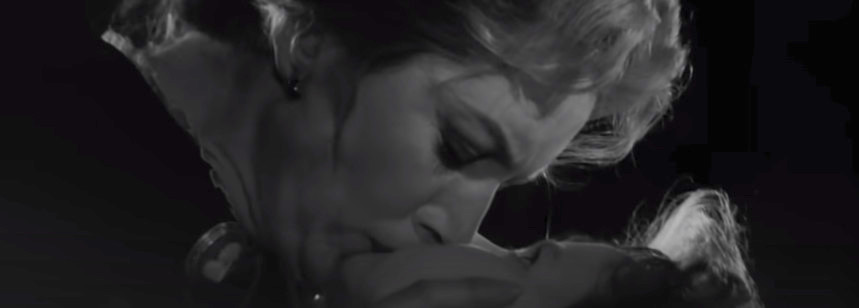
The notorious final kiss in which the Giddens kisses Miles’s dead face: not exactly the kiss of a parent or guardian, but certainly infused with passion.
This is flirtatiousness to match her flirting with the uncle, and much of the dialogue between Miles and the Governess is preserved in the film. But Clayton takes the sexual implications of their conversation much further, particularly in the form of two extended kisses: one in the bedroom when Miles kisses her as if he were a grown man, and in the lover’s kiss she gives to him at the film’s deadly climax. The second of these was problematic for the commercial distributor, 20th Century Fox, and seems to modern audiences to carry the taint of paedophilia, but Clayton refused to remove his controversial final action. This climactic scene is coloured by Miles’s earlier judgment, when he appears to be possessed by Quint, accusing Giddens of being ‘a filthy hag … a damned hussy’. Both texts are about possession, but it could be that the Governess is possessed and overwhelmed by her innermost desires.
Evaluation
Balancing all of these contradictory elements, The Innocents is an open-ended filmic text which reproduces the dense ambiguities of James’s written text. It maintains the narrative, matches most of the tale’s key scenes, preserves a great deal of the dialogue and characterization, and reproduces the Governess’s perspective by reporting events as she sees and hears them. James’s writing of a narrator who may be unreliable is given brilliant equivalence in the film’s subjectivism, recasting her impressions in terms of grotesque imagery, blurred and uncertain perceptions and distorted non-diegetic sound that pretends to be naturalistic. Employing this cinematic language to create a thoroughly unsettling montage, a masterwork of implication, Clayton ensures that his version of The Turn of the Screw is a filmic reflection of what may – or may not – be a truthful representation of a series of events. Douglas, the narrator of the Prologue, insists that James’s tale ‘won’t tell’ [author's emphasis], at least not in ‘any literal, vulgar way’ (4) and the same is true of the film. Taken together, The Turn of the Screw and The Innocents are dense fields of irreducible possibilities, and disturbing in equal measure because it is impossible to identify which reading is correct.
What they certainly do is create a sustained impression of what Douglas describes as a ‘general uncanny ugliness and horror and pain’ (Turn of Screw, 2). Possession may be the theme of the two texts, and even if the supernatural is purely imaginary the film and novelette unquestionably have the effect of haunting their readers and viewers.
Note
The Innocents is available, with commentary by Christopher Frayling, in the form of a BFI DVD, catalogue number BFIVD675. It is also available, to watch and share, on Youtube. This was the source of the screen shots in this review.
Bibliography
Clayton, Jack. The Innocents. Achilles Film Productions, distributed by Twentieth Century Fox, 1961.
Frayling, Christopher. The Innocents. London: Palgrave Macmillan, 2013.
James, Henry. The Turn of the Screw. 1898; Seattle: Coffeetown Press, 2010.
Mazzella, Anthony J. ‘The Story … Held Us: The Turn of the Screw. from Henry James to Jack Clayton.’ Henry James Goes to the Movies. Ed. Susan Griffiths. Lexington: University of Kentucky Press, 2002 (online edition).
Palmer, James W. ‘Cinematic Ambiguity: James’s The Turn of the Screw and Clayton’s The Innocents.’ Literature/Film Quarterly. 5:3 (Summer 1977): 198–215.
Recchia, Edward. ‘An Eye for an I: Adapting Henry James’s The Turn of the Screw to the Screen.’ Literature/Film Quarterly 15:1 (1987): 28–35.
Sinyard, Neil. Jack Clayton. Manchester: Manchester University Press, 2000.
Wilson, Edmund. “The Ambiguity of Henry James.” Hound and Horn 7 (April–June 1934): 385–406.
Created 26 November 2022